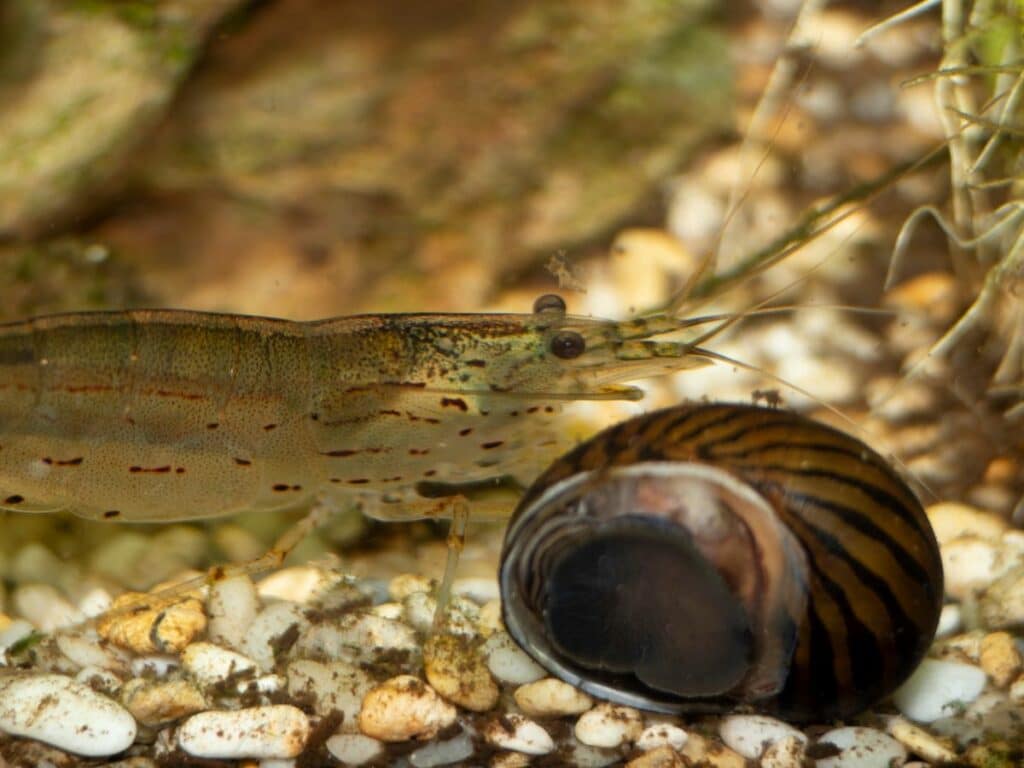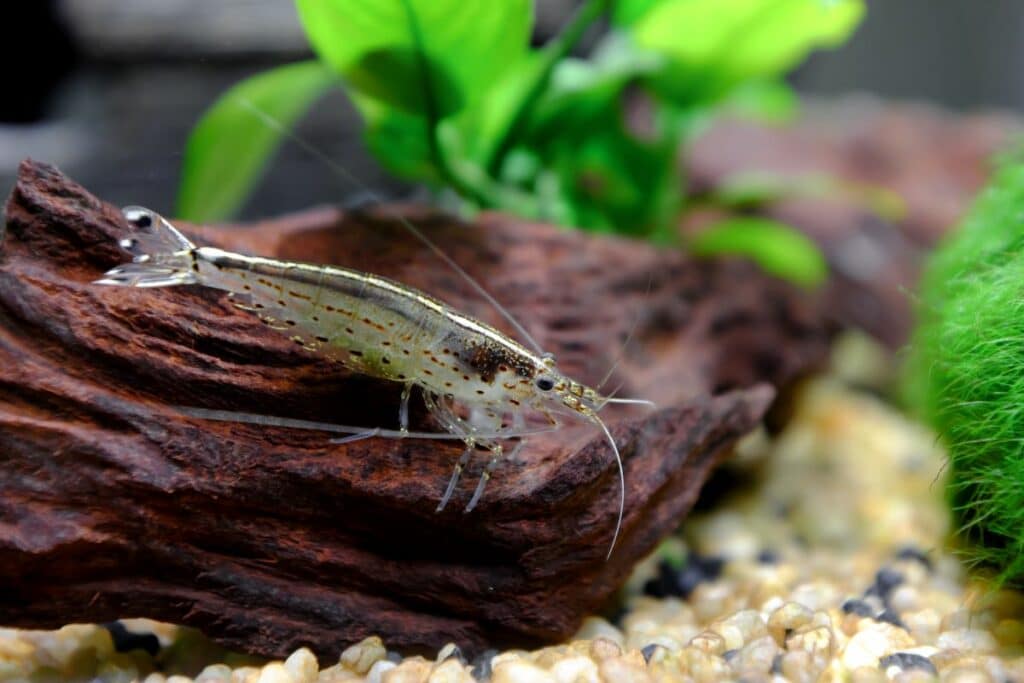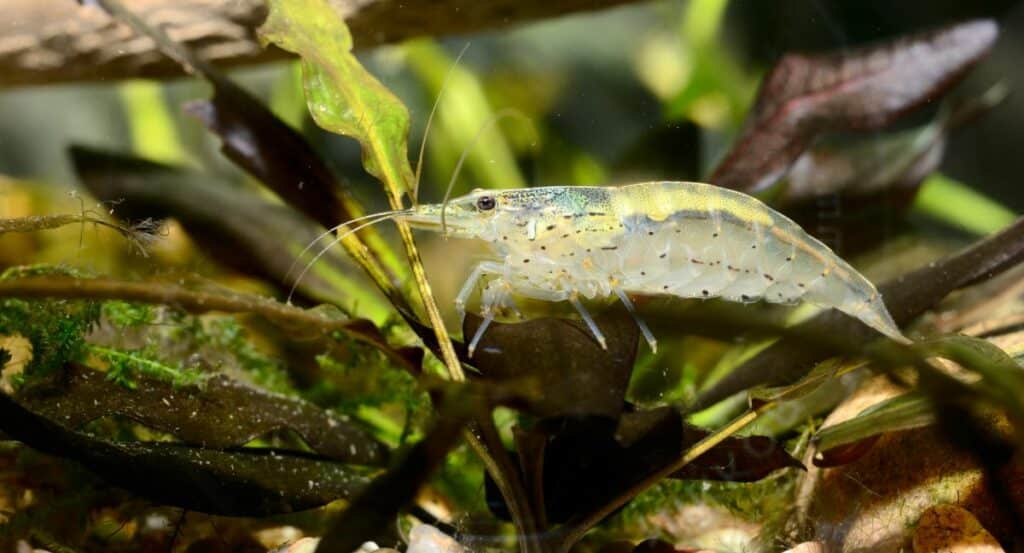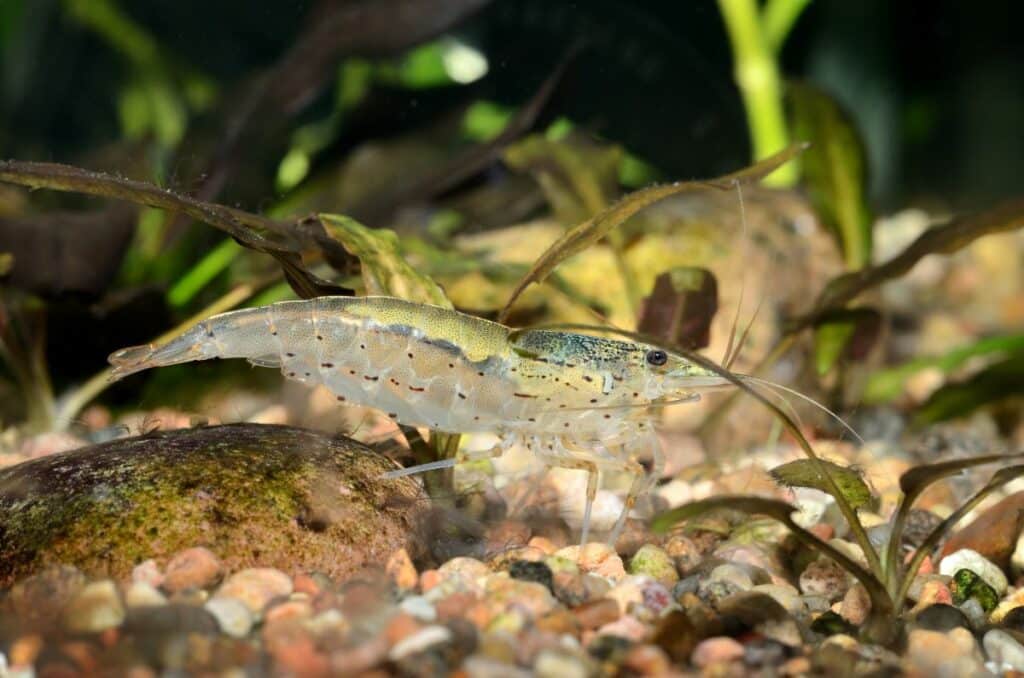the essentials in brief
10-20 animals are recommended for successful breeding of Amano shrimp. More info on how to breed Amano shrimp…
Amano shrimp need clean water, a balanced diet, appropriate temperatures, appropriate pH and enough hiding places.
Amano shrimp get along well with most peaceful shrimp species such as Neocaridina and Caridina. To the profile of the shrimp…
Amano Shrimp - These small aquatic creatures have a special appeal that captivates both novice and experienced aquarists. In this post we go on a fascinating journey through the life of these shrimp and take a close look at their care, husbandry and special features.
What are Amano shrimp?

Anyone who has ever strolled through an aquarium or pet shop and taken a look at the different types of shrimp has probably stumbled across the name Amano shrimp. But what exactly are Amano shrimp and why are they so popular among aquarists?
The Amano shrimp, scientifically known as Caridina multidentata known is one freshwater shrimp, originally from Southeast Asia. Their natural habitats are rivers and streams surrounded by dense forest. They prefer clear, cool waters with soft to moderately hard water.
They got their common name from the Japanese aquarist and photographer Takashi Amano preserved, which popularized this species in the 1980s. He was a pioneer of "nature aquaristics" and used Amano shrimp on a large scale for the first time in his beautiful aquariums.
Amano shrimp are known for their algae fighting ability. They are tireless eating machines, which can make a significant contribution to the cleanliness and health of the aquarium. Additionally, they are valued for their peaceful nature and ability to get along well with a variety of fish and other shrimp species.
A length of about 5 centimeters Amano shrimp are larger than most other shrimp species kept in home aquariums. They have a transparent to gray-brown coloration that allows them to blend in well with their surroundings.
Note: Their natural propensity to fight algae, peaceful nature and easy care make them an excellent choice for both novice and experienced aquarists.
Characteristics of the Amano shrimp
| Property | Detail |
| Scientific name | Caridina multidentata |
| common name | Amano shrimp |
| Origin | Southeast Asia |
| Living Space | rivers and streams |
| Size | Up to 5 cm |
| Life expectancy | 2-3 years |
| Color | Transparent to grey-brown |
| Behavior | Peaceful, sociable |
| Feed | Algae, dead plants, uneaten food |
| Temperature | Optimum between 22 and 28 degrees Celsius |
| PH value | Optimal between 6,5 and 7,5 |
| degree of hardness of the water | Soft to medium hard |
| Reproduction | Laying eggs, larvae need saline water for development |
| Features | Excellent algae eaters, can live well with various fish and shrimp |
What do Amano shrimp need for optimal husbandry?

Amano shrimp husbandry requires some specific conditions to ensure these fascinating creatures stay healthy and reach their full potential.
Aquarium size and setup
An aquarium for Amano shrimp should be one Minimum volume of 30 liters exhibit. The larger the aquarium the better as this gives the shrimp more room to explore and interact with their surroundings.
The setup of the aquarium should be based on the natural habitat of the shrimp and be adapted to their specific needs. This includes enough hiding places and a good amount of live plants. Rocks, roots and special shrimp burrows can serve as hiding places while also providing surfaces for algae growth for the shrimp to feed on. Plants not only contribute to the overall aesthetics of the aquarium, but also serve as an additional source of food and provide additional protection.
water conditions
Amano shrimp require clean, well-filtered water. They prefer a water temperature between 22 and 28 degrees Celsius and a pH value between 6,5 and 7,5. They get along well with soft to medium-hard water, a degree of hardness between 4 and 12 °dH is optimal.
An regular monitoring and adjustment of water parameters is essential to ensure the conditions are optimal for the shrimp.
Amano shrimp in the kitchen?
Amano shrimp are considered a delicacy in their native Japan and are often served deep-fried in tempura batter.
What do Amano shrimp eat?
Known to be omnivores, Amano shrimp have a diverse diet that helps them maintain healthy growth and robust health.
- Algae and Biofilm: Much of the Amano shrimp's diet consists of algae and biofilm, which they scrape from the surfaces in the aquarium. This makes them effective algae killers and helps keep the aquarium clean.
- Leftover food and detritus: In addition to algae and biofilm, Amano shrimp also eat dead plant material, uneaten food and occasionally even dead fish or shrimp. This makes them valuable helpers in maintaining a clean and healthy aquarium.
- Additional Lining: Although algae and biofilm are their main food source, it can be helpful to supplement the Amano shrimp's diet with additional food. Specialty shrimp food, veggies like shredded spinach or cucumber, and even frozen or live feed like artemia or daphnia can provide a welcome change.
Note: It is important to remember that when feeding Amano shrimp, excess should be avoided so as not to affect the water quality. A good sign that the shrimp are being fed adequately, but not excessively, is when the food is eaten completely within two to three hours.
How do I breed Amano shrimp?

Farming Amano shrimp can be an exciting but challenging task. Unlike many other shrimp species, Amano shrimp eggs develop into Larvae, which require special conditions to develop into adult shrimp.
After mating, the female lays the eggs and carries them under her abdomen until they are ready to hatch. These eggs then hatch into tiny larvae that float in free water.
The key to successfully breeding Amano shrimp lies in the understanding this early stage of life. The larvae require saline water for their development, similar to the conditions in a brackish water environment that they would find in their natural environment.
Therefore, it is important to provide a separate rearing tank with saline water, into which the larvae can be translocated once they have hatched. The larvae will then spend a few weeks in this salty water before developing into young shrimp, which can then be translocated to fresh water.
Tip: Patience and close observation are important for breeding Amano shrimp. The larvae are very small and easily overlooked. They are also very delicate at this stage and need optimal conditions to survive and develop.
The charm of Amano shrimp
Keeping and possibly even breeding Amano shrimp can be an enriching experience that will add life and color to your aquarium. These tireless algae eaters make a significant contribution Cleanliness and health of your aquarium and are pleasantly easy to care for. However, successfully breeding these shrimp requires patience and careful monitoring. Still, the beauty and benefits that Amano shrimp bring to any aquarium is worth the effort.



